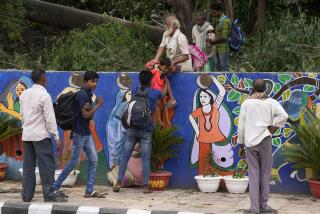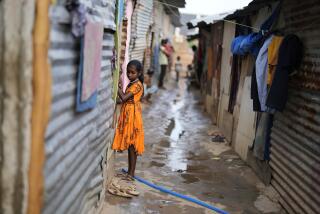Photo Essay : FACES OF BOMBAY
- Share via
BOMBAY, India — “Every day, it gets worse and worse as physical environment . . . and yet better and better as city,” is one Indian architect’s verdict. “Every day, it offers more skills, activities and opportunities on every level.”
And more people. From the shantytowns of pathetic makeshift hovels that start within yards of Bombay’s international airport to miserable shelters built under the hulls of beached fishing boats by the Arabian Sea, Bombay is a slowly but inexorably rising tide of humanity.
No one knows for sure how many people live in this multiethnic Babel. Most official sources say 12.7 million--more than in New York City and Los Angeles combined. Whatever the count, half of the men, women and children in Bombay live in appalling slums or on the hard pavement.
From Tamil Nadu, Gujarat or Goa, they are still coming to India’s El Dorado, its financial, industrial, commercial, trading and filmmaking center, or its criminal underworld, to try to make it or just to panhandle enough to survive.
In this city of seven hot, boggy, malarial islands acquired by the British for next to nothing (and leased for a time by the East India Co. for 10 pounds sterling a year), property values now rival those in the priciest Western cities. Bombay is proof to Indians that everything and anything is possible.
At the Bombay Stock Exchange, officials can point from the windows of their high-rise offices to a magnificent stone tower constructed for 5 million rupees by a Parsee cotton merchant who got fabulously rich off the boom in cotton sparked by the American Civil War.
Not far away, near Jordache Plaza--an upscale shop with a candy-striped awning selling licensed Indian-made clothes with the Jordache label--entire families who have fled a dirt-poor existence in farm villages sleep on the sidewalk under the banyan trees.
The very essence of Bombay is in such contrasts.
Bombay’s abiding obsession is making money, and news vendors hawk a bewildering array of tabloids and magazines: Rupee, Money Times, Capital, Premium Investments, Financial Wizard and so on. Even a Mr. Patel, the proprietor of a modest fruit and cold drink stand, has gotten business cards printed to show others he’s somebody.
Bombay residents like to think they inhabit India’s most cosmopolitan and sophisticated city, but the ethnic strife that shattered India last year did not spare them. On the contrary, Hindu-Muslim violence was at its bloodiest in the slums here, where more than 600 people died in rioting in January, 1993. Two months later, a series of bomb explosions tore through the heart of the financial district, killing at least 250 people. Outside the stock exchange, they are still patching the craters.
One of Bombay’s young stockbrokers has been reading a book titled “Thriving on Chaos.” It sounds like a guide to life in this unique and perplexing city, where cabbies and starlets alike are proud to have an attitude and where barefoot urchins stake out a space on Dalal Street, India’s answer to Wall Street, to play marbles while ambitious young clerks in white shirts hurry past.
More to Read
Sign up for Essential California
The most important California stories and recommendations in your inbox every morning.
You may occasionally receive promotional content from the Los Angeles Times.













